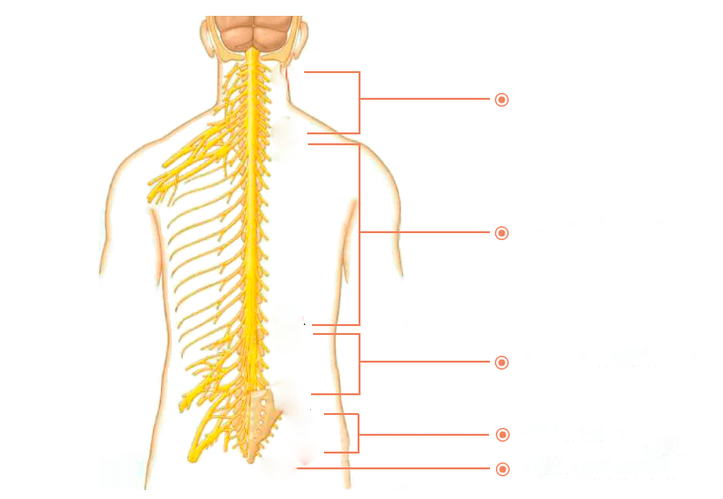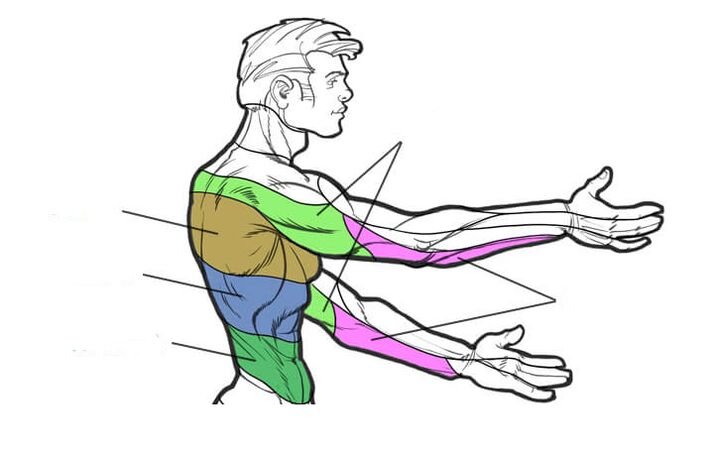The thoracic spine has one feature - the ribs join it. This makes it less agile than the neck and lower back. Consequently, osteochondrosis of the thoracic region is less common, according to the principle "less mobility - less wear". But it develops less often - that doesn’t mean it’s easier. And it really is. It's about chest pain. Because the pain zone of the thoracic spine coincides with the zone of the heart, the symptoms are often confused with angina pectoris or myocardial infarction. No wonder chest osteochondrosis is said to be a "chameleon. " It can play not only heart disease, but also lung, liver, stomach, gallbladder, or pancreas disease. And you can’t make mistakes here and ignore a heart attack. or other serious illnesses, such as the pathology of a woman’s mammary glands. Such flaws are costly, even if they work in the end. After all, it can "lead" a person to severe stress. Therefore, it is very important to find an experienced and knowledgeable doctor who understands everything and distinguishes the symptoms of chest osteochondrosis from other pathologies. Symptoms of osteochondrosis of the thoracic region usually fall into two categories - radical and reflex.
Radicular symptoms
They are caused by the effect on the nerves leaving the spine.
spinal nerves

A lot of nerves come out of the spine. These are called spinal nerves. Each such nerve gradually branches and follows a certain area of the body with clearly defined boundaries. This area is called the zone of segmental innervation. The numbering of all vertebrae, discs, nerves, and zones is strictly consistent. If the nerve is affected, the symptoms appear in the segmental innervation zone corresponding to the nerve, and not anywhere - anywhere.
Radical symptoms include:
- decrease or loss of reflexes;
- Violation of sensitivity;
- muscle weakness;
- Sore pain.
Nervous zones of the thoracic sections
Osteochondrosis D1-D2- causes pain in the shoulder, collarbone and armpits.

Osteochondrosis D3-D6- Causes pain, belting in the upper chest. Simulates heart pain, an attack of angina pectoris. It causes pain in the mammary glands in women.
Osteochondrosis D7-D8- causes belt pain at the level of the solar plexus. It simulates pain in the stomach, liver, gallbladder, or pancreas. Reduces upper abdominal reflexes.
Osteochondrosis D9-D10- causes pain in the hypochondria and upper abdomen. Sometimes it mimics the so-called "acute" abdomen - a sharp pain in the abdomen. Reduces middle abdominal reflexes.
Osteochondrosis D11-D12- causes pain in the lumbar region. It simulates pain in women's diseases, appendicitis, intestinal diseases. Reduces lower abdominal reflexes.
Reflex symptoms
Unlike radicularis, reflex symptoms have no clear boundaries. These may include: difficulty breathing, shortness of breath, pain when inhaling, chills and "goosebumps" on the skin, intercostal neuralgia, chest pain in the chest. Dyspepsia is common - loss of appetite, nausea, heartburn, bloating and faecal disturbances. Due to the pain, sleep causes disturbance, insomnia and a feeling that you have not slept enough. It's hard to move, especially in the morning. The coordination of movements is disturbed - this is reflected in the district. General weakness, weakness. Violations in the sexual sphere. Irritability. Fast exhaustion. There are different types of pain. Depressing pains in the chest. Pain in the shoulder blades. Pain in the hypochondria. Pain when lifting the arms. Pain when bending or straightening. Pain in the shoulder blades. In general, pain in osteochondrosis of the thoracic region can be divided into two types.
Dorsalgia- moderate, prolonged pain in the back and chest, with periods of worsening and weakening.
Dorsago- Acute pain "lumbago" in this area.
- The symptoms of osteochondrosis of the thoracic region depend on the stage of osteochondrosis.
- They are aggravated by bending or straightening.
- Symptoms often appear after 35-45 years.
- It is about three times more common in women than men.
Of course, he noticed that the radical symptoms were clearly defined and the reflex symptoms were very vague and non-specific. And as you know, anything that doesn’t have a clear definition is a convenient cover for professional inertia. This includes reflex symptoms and a term favored by doctors, such as "age-related changes. " Surely many of you are aware of a situation where a doctor has explained the problem with "reflexive" or "age-related" processes. Most people rightlyhe believes that the doctor simply cannot figure out what is happening and is trying to cover up his unfitness in the mists of these "magic words".
At one time there was a popular phrase, "Every accident has a name, a last name, and a position. " Each disease has its own unique symptoms. And it is the duty of the doctor to know them clearly. And then you don’t have to let in the fog and blame the osteochondrosis of the chest region for everything. Now you understand how important it is to find an experienced and knowledgeable doctor. Both a correct diagnosis and good treatment outcomes depend on this.
Diagnosis is the key to proper treatment
To date, there are several modern methods for hardware diagnosis of osteochondrosis. The most accurate of these are MRI and CT. However, the main method still compares data from clinical diagnosis, in which case an experienced physician from at least three sources — patient complaints, MRI results, and symptoms revealed during the study. This allows you to make the most accurate diagnosis and create an effective individual treatment program.
Treatment
As soon as you understand, osteochondrosis is a real "tangle" of symptoms that, if resolved, will save you from pain and suffering. But changes in the vertebrae and discs cannot be eliminated. Therefore, the words "treat osteochondrosis" should be understood correctly. and the elimination of other sufferings, then yes — it is entirely possible. And if you have a scientific debate about restoring the original appearance of vertebrae and cartilage discs, "like a newborn child, " then no, the past cannot be returned. You have to be realistic and then you won’t fall into the lure of scammers.
Don't fall for the lures of scammers!
It is impossible to restore the original appearance of the vertebrae and cartilage discs!
What is the main treatment method?
Soft manual therapy is the main type of treatment for osteochondrosis of the thoracic region. It’s like an antibiotic for pneumonia - you can’t do without it. Other types - massage, medication, physiotherapy and movement therapy - are complementary.
How does gentle manual therapy work?
The nutrition of the cartilage discs is directly related to the muscles surrounding the spine. In addition, the back muscles themselves are a major cause of pain in osteochondrosis of the thoracic region. Soft manual therapy is a special method that allows muscles to return to their natural physiology, eliminates cramps, muscle tightness and improves the nutrition of the cartilage disc.
Intervertebral discs are the only part of the body that lacks blood vessels and feeds on the proper functioning of the muscles.
In addition, during manual treatment, the chiropractor:
- remove the load from the affected vertebrae and discs and distribute it properly;
- relax your muscles and help you return to normal;
Thus:
- save the patient from the clamps;
- improves disk performance;
- restores the motor functions of the body;
- normalizes blood circulation.
The manual blow mobilizes the internal forces of the body and triggers self-healing mechanisms.
The treatment is completely safe.
Prevention
To avoid relapses, create comfortable conditions for sleeping and working. Pay attention to your weight and proper nutrition. Maintains physical activity. But the most important thing is not to neglect or save on your health. Don’t let things go by themselves. After recovery, try at least one maintenance treatment every 3 to 6 months - this will reduce risk factors. Remember, neglected osteochondrosis leads to complications - protrusion and disc herniation. Remember: you need health first and foremost!
Running osteochondrosis leads to complications - protrusion and disc herniation.














































